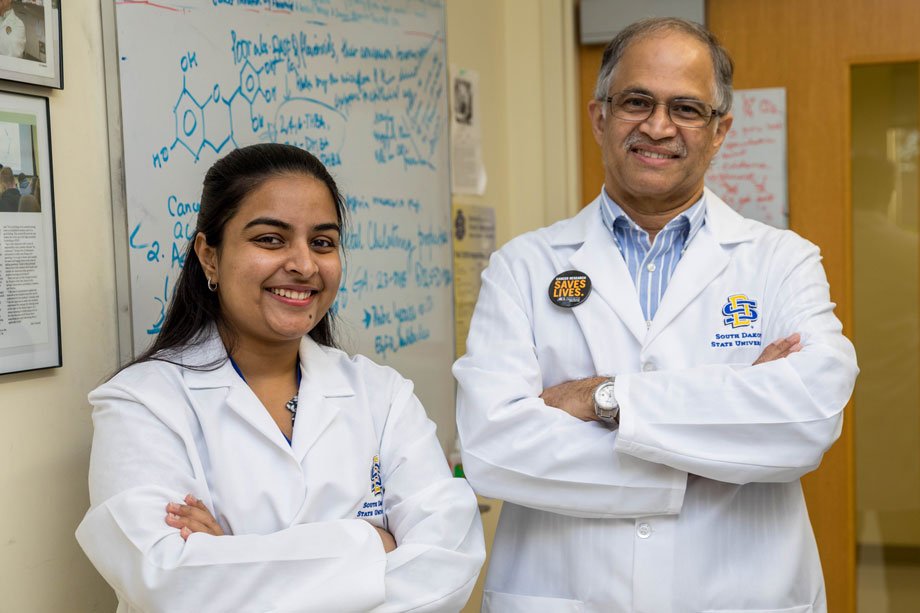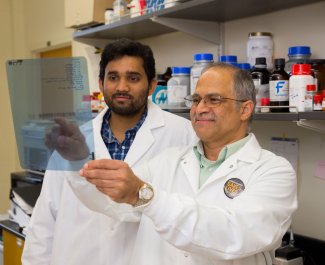
A diet rich in fruits and vegetables and a daily dose of aspirin have one thing in common—both can help prevent colorectal cancer. Yet scientists have struggled for decades to find the source of their ability to inhibit cancer cell growth.
The answer may lie in the compounds produced when the body breaks down, or metabolizes, aspirin, and flavonoids present in fruits and vegetables, according to associate professor Jayarama Gunaje of SDSU’s Department of Pharmaceutical Sciences. He proposes “the metabolite hypothesis” in the May issue of Molecules, an international peer-reviewed journal.
Only 40 to 50% of aspirin and less than 15% of flavonoids are absorbed in the bloodstream, Gunaje explained. Therefore, substantial amounts of aspirin and flavonoids reach the intestines, where host and bacterial enzymes degrade the compounds. This process results in simpler phenolic acids, specifically hydroxybenzoic acids, or HBAs, that may contribute to colorectal cancer prevention.
“Plants also have the capacity to make these metabolites. Fruits and vegetables are loaded with free HBAs, which act as antioxidants and also help the plants fight infections,” Gunaje pointed out. Consumption of fruits and vegetables in the diet is another source HBAs.
Gunaje’s colorectal cancer research was supported by the SDSU Research and Scholarship Support Fund, Scholarly Faculty Excellence Fund, the Department of Pharmaceutical Sciences and the Translational Cancer Research Center.
Identifying the metabolites and the gut bacteria responsible for degradation of aspirin and flavonoids will help scientists develop probiotics and possibly supplements to help prevent colorectal cancer.
“One in 23 men and one in 25 women will develop cancer of the colon, rectum or both in their lifetime,” according to the American Cancer Society. It is the third-leading cause of cancer death among Americans.

Examining aspirin metabolites
While investigating how aspirin decreases colorectal cancer risk, Gunaje and doctoral student Rakesh Dachineni, who is now a formulation scientist for Foresee Pharmaceuticals Inc., found the parent compounds, aspirin and salicylic acid, had no effect on enzymes called cyclin-dependent kinases that regulate cell division. That led them to examine whether the cancer-fighting power might be coming from aspirin and salicylic acid metabolites called dihydroxybenzoic acids.
Testing showed that the aspirin metabolite 2,5-dihydroxybenzoic acid was universally effective in inhibiting the growth in colorectal cancer cell lines. Another metabolite—2,3-DHBA—inhibited the growth of a line of breast cancer cells, but did not inhibit colorectal cancer cell growth.
Furthermore, the researchers also found that, 2,4,6 trihydroxybenzoic acid, a derivative of salicylic acid, was capable of inhibiting cyclin-dependent kinases and cancer cell growth. These results were first published in the December 2017 International Journal of Oncology, and, more recently in the January 2020 issue of Molecular Medicine Reports.
Investigating flavonoids
Based on the findings about aspirin metabolites, Gunaje and doctoral student Ranjini Sankaranarayanan began looking for natural sources of 2,4,6-THBA. That led them to focus on the polyphenolic flavonoids in fruits and vegetables. Flavonoids are abundant in fruits and vegetables, such as blackberries, blueberries, red grapes, apples and red onions, and in chocolate, tea and red wine.
They found that 2,4,6-THBA, one of the compounds produced when the body metabolizes or breaks down flavonoids, can inhibit cancer cell growth under specific conditions. Their work was published in the March 2019 issue of Cancers.
“Whether the HBA metabolites are from flavonoids or aspirin, they can inhibit cancer cell growth,” Gunaje said. When cells are exposed to HBAs generated through bacteria in the gut, this reduces the rate of cancer cell growth.
That growth rate reduction likely gives immune cells, such as T cells and natural killer cells, a greater window of opportunity to destroy the cancer cells. In addition, when a normal cell contains damaged DNA, mutations can occur. The slowdown in cell proliferation may provide time for the cells to repair their DNA, thereby preventing the accumulation of mutations, Gunaje pointed out.
“Cancer prevention involves a partnership between the compounds and microbial species in the gut,” Gunaje said. Other research groups have also found evidence that the degraded products are more likely responsible for cancer prevention than the parent molecules.
By proposing the metabolite hypothesis, he and his research group hope to encourage further studies on the role HBAs play in cancer prevention. “If it is proven true, we will have opened up a new frontier of research and potential strategies for the prevention of colorectal cancers,” he concluded.
Republishing
You may republish SDSU News Center articles for free, online or in print. Questions? Contact us at sdsu.news@sdstate.edu or 605-688-6161.

